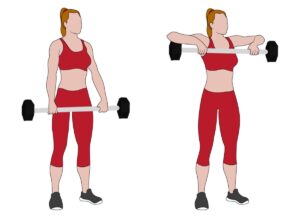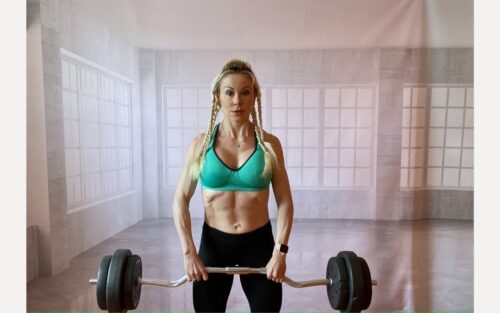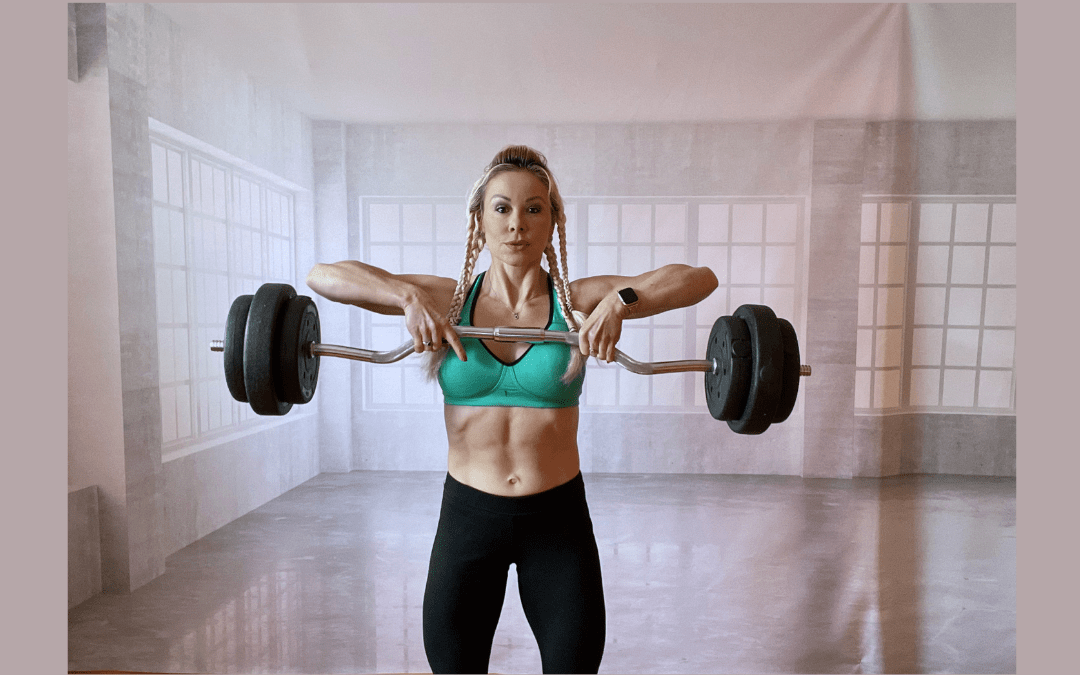Sculpt your upper body by working out your shoulders. A great exercise to build and strengthen the shoulder muscles is the upright row. Below we’ll look deeper into upright rows and we’ll cover the following:
- Muscles involved in upright rows
- Benefits associated with upright rows
- How to properly do upright rows
- Upright rows’ modifications
- Common mistakes when performing upright rows
- Shoulder exercises to complete your shoulder workout
- Video on how to do upright rows
Muscles Worked in Upright Rows
The shoulder is the main muscle group being worked on. It has several muscles that attach to the scapula, humerus, and clavicle. The largest shoulder muscle is the deltoid, which consists of the anterior, middle, and posterior fibers, giving the shoulder that nice rounded look. There are other muscles — the supraspinatus, infraspinatus, teres minor, and subscapularis — that form the rotator cuff and are vital in the dynamics of shoulder movement.
The upright row is a compound exercise that targets several muscles:
- Anterior deltoids – the front of the shoulders
- Lateral deltoids – the side of the shoulders
- Posterior deltoids – the rear part of the shoulders
- Trapezius – triangular muscles extending over the back of the neck and shoulders
- Rhomboids – muscles located in the upper back in between the scapulas
Benefits of Upright Rows
- Strength: Upright rows help increase shoulder strength.
- Aesthetics & Hypertrophy: They help sculpt fuller, more defined shoulders and traps.
- Fat Loss & Efficiency: The upright row is a compound move that works multiple joints and muscles simultaneously and helps you burn more calories.
- Shoulder Stability & Mobility: The shoulder area is one of the most mobile spheres in the body, allowing for a wide range of motion – rotation, abduction, and adduction. Simultaneously, this versatility makes the shoulder area more prone to injury. This exercise requires internal rotation of the shoulder and works all areas of the deltoids, helping to keep a stable and mobile shoulder joint.
- Posture: Working the anterior, medial, and posterior deltoids, as well as the traps and upper back muscles, helps draw back the shoulders and maintain a more upright posture.
- Exercise Performance: Upright rows help improve shoulder mobility which translates into improved athletic performance during other exercises, such as cleans and snatches. You can increase muscular endurance by using lighter loads for 12-20 reps and 2-4 sets
How to Do Upright Barbell Rows

- Grab a barbell and hold it with an overhand grip down in front of you with your arms extended. Your hands should be positioned at shoulder-width distance.
- Stand tall with your feet shoulder-width apart, back straight, shoulders back, and core tight.
- Lift the barbell up, pulling through your elbows and keeping the weight close to your body.
- Stop when the barbell is at chest level and your elbows are level with your shoulders.
- Pause at the top for a couple of seconds and bring the bar down to the starting position.
- Repeat 8-15 times.
*️⃣ You can perform upright rows with dumbbells, a kettlebell, or a barbell.
*️⃣ You can change your hand positioning to challenge different areas: a shoulder-width grip emphasizes the lateral deltoids and trapezius, a wider grip targets more of the posterior shoulders, and a narrower grip targets more of the traps and anterior delts.
*️⃣ If you have any shoulder injuries, be cautious. Having your hands locked into position while lifting the bar, internally rotates the shoulders and can irritate shoulder tendons if not performed properly.
Upright Barbell Rows Mistakes

- Avoid lifting your elbows too high – Lifting your arms higher than parallel to the floor can cause shoulder injuries (shoulder impingement or bursitis). Stop when your elbows reach shoulder level.
- Avoid using too much weight – Upright rows don’t require a lot of weight to obtain results. Use a weight that allows you to perform this exercise without using momentum, with a full range of motion, and maintaining control so you can pause slightly at the top and slowly lower the bar.
- Avoid rounding your back – Keep your core engaged and your back straight so you isolate your delts, traps, and upper back instead of putting stress on your back.
- Avoid lifting the bar far away from your body – Keep the bar close to your body so you move the load with the right muscles rather than using your biceps or forearms.
Upright Barbell Row Video
Shoulder Workout
Now that you know how to do upright rows, as well as all their benefits and common mistakes, you can complete your shoulder workout by performing other shoulder exercises: Barbell Front Raise, Lateral Raises, Face Pulls, and Arnold Presses.
Lift, Burn more Fat, Get Stronger, and Live Healthier!
To a Fitter Healthier You,
The Fitness Wellness Mentor



